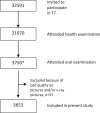Dentists' Treatment Decisions Concerning Restorations in Adult Patients in North Norway: A Cross-Sectional Tromsø 7 Study
- PMID: 39510050
- PMCID: PMC11975315
- DOI: 10.1159/000541777
Dentists' Treatment Decisions Concerning Restorations in Adult Patients in North Norway: A Cross-Sectional Tromsø 7 Study
Abstract
Introduction: The aim of this cross-sectional study was to explore the degree whereby dentists differentiate between repair versus replacement for failed restorations. A random selection of adult patients from North Norway was chosen from the larger Tromsø 7 study.
Methods: A randomized sample of 3,653 persons (11.5% of the total number of individuals invited to the Tromsø 7 study, 51.5% women, aged 40-93 years) were included. Based on FDI's clinical criteria for the evaluation of restorations - 2010, 17 calibrated dentists evaluated patients by clinical and radiographical pictures in a specially designed software developed for this purpose. The dental practitioners' opinions gave rise to the reported treatment decisions. Descriptive statistics and multivariable multilevel mixed-effect logistic regression models (STATA 17/SE) were performed.
Results: The participants' DMFT values ranged from 0 (0.9%) to 24 (8.8%) (median DMFT 21.3, mean 20.0). A total of 90.062 teeth (24.7 teeth per patient) were assessed. Re-treatment suggestions were made for 3,006 restorations, i.e., an average of 3.3% re-treatments. Of these, 25.3% (n = 814) were suggested for repair and 74.7% (n = 2,192) for replacement. Dental treatment was suggested for 1,597 patients and varying from 1 to 14 suggestions per patient. Secondary caries (37.6%) and restoration fracture (15.2%) were found to be most frequently used indications for re-treatment, surface properties the least. No significant difference was found between assessing dentists based on sex or age. Clustering by dentist level was checked using intra-class correlation coefficients, demonstrating that 16% of the variance in suggestions for restoration re-treatment was explained at the dentist level. Thus, a wide range of treatment suggestions was noted among the dentists.
Conclusion: Need for restoration revision seems low in North Norway. There is a tendency towards larger and more indirect restorations, and the diagnosis of secondary caries is still a matter of uncertainty.
Keywords: Cross-sectional study; Minimal invasive dentistry; Repair; Replace; Restoration.
© 2024 The Author(s). Published by S. Karger AG, Basel.
Conflict of interest statement
The authors have no conflicts of interest to declare.
Figures





Similar articles
-
Repair or replacement of defective restorations by dentists in The Dental Practice-Based Research Network.J Am Dent Assoc. 2012 Jun;143(6):593-601. doi: 10.14219/jada.archive.2012.0238. J Am Dent Assoc. 2012. PMID: 22653939 Free PMC article.
-
The Post-Amalgam Era: Norwegian Dentists' Experiences with Composite Resins and Repair of Defective Amalgam Restorations.Int J Environ Res Public Health. 2016 Apr 22;13(4):441. doi: 10.3390/ijerph13040441. Int J Environ Res Public Health. 2016. PMID: 27110804 Free PMC article.
-
Repair of defective composite restorations. A questionnaire study among dentists in the Public Dental Service in Norway.J Dent. 2016 Sep;52:50-4. doi: 10.1016/j.jdent.2016.07.004. Epub 2016 Jul 12. J Dent. 2016. PMID: 27421988
-
An update on the reasons for placement and replacement of direct restorations.J Dent. 2018 May;72:1-7. doi: 10.1016/j.jdent.2018.03.001. Epub 2018 Mar 6. J Dent. 2018. PMID: 29522787 Review.
-
Understanding the management and teaching of dental restoration repair: Systematic review and meta-analysis of surveys.J Dent. 2018 Feb;69:1-21. doi: 10.1016/j.jdent.2017.09.010. Epub 2017 Sep 21. J Dent. 2018. PMID: 28943362
Cited by
-
Practice-Level Variation in the Provision of Subsidised Dental Services to Adult Danes in 2019: A Register-Based Study.Community Dent Oral Epidemiol. 2025 Aug;53(4):452-464. doi: 10.1111/cdoe.13048. Epub 2025 Jun 3. Community Dent Oral Epidemiol. 2025. PMID: 40462288 Free PMC article.
References
-
- Helsedirektoratet, God klinisk praksis i tannhelsetjenesten. 2011; [HOD].
-
- FDI, FDI Policy statement . Minimal Intervention in the management of dental caries. 2002; p. 101–2.
-
- FDI . Minimal intervention dentistry (MID) for managing dental caries Published on FDI World dental federation. FDI; 2016. https://www.fdiworlddental.org - PMC - PubMed
-
- Hickel R, Brushaver K, Ilie N. Repair of restorations: criteria for decision making and clinical recommendations. Dent Mater. 2013;29(1):28–50. - PubMed
MeSH terms
LinkOut - more resources
Full Text Sources

